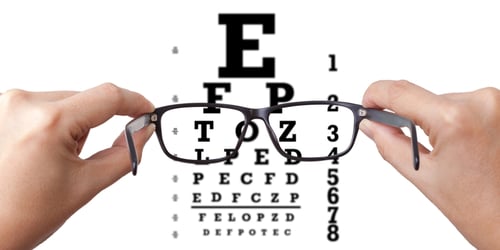Getting a better understanding of what your vision prescription means.
Everyone knows that the term “20/20” often means perfect vision. If someone tells you that their eyes are 20/20, they do not need any kind of prescription eyeglasses, contact lenses or LASIK surgery in order to see clearly each and every day. (Those lucky people!) However, aside from the fact that it means perfect vision, do you actually know what 20/20 vision means and represents? Many people, even those who may have their own eyeglasses prescription, do not!
To help you better understand your prescription and the different levels of visual acuity, today we are looking closer at the different methods of vision prescriptions that your eye doctor may discuss with you during an annual eye examination for prescription lenses.
The Snellen Chart for Vision Testing
If you have ever stood at the doctor’s office and been asked to read off letters or numbers (or for children, look at objects) that are placed far ahead of you, you have likely seen the Snellen Chart. This popular vision test requires people to stand 20 feet away from a piece of paper that features letters in a progressively smaller size on each line.
Someone with perfect vision (20/20) would be able to see the same line of letter from 20 feet away that a normal person sees at 20 feet away. However, someone with 20/40 vision sees at 20 feet away what a normal person sees at 40 feet away. (This also means that someone with 20/40 vision has eyesight that is only half as good as normal―20/20.)
Your Eyeglass Prescription
For anyone that has gone to an ophthalmologist or optometrist for a vision test or updated prescription, you have probably been handed a piece of paper with a whole bunch of confusing numbers on it and have been told that is your prescription. But what do these numbers mean exactly?
There are usually five different numbers that you will see on your vision prescription, along with a base direction:
- Sphere (SPH): The amount of lens power (measured in diopters) that are prescribed to correct nearsightedness or farsightedness. If the number is accompanied by a plus sign (+), you are farsighted. If the number has a minus sign (-), you are nearsighted.
- Cylinder (CYL): The amount of lens power that is prescribed if you have astigmatism. If nothing appears in this section, you either have zero astigmatism or it is so very small that it is not necessary to correct.
- Axis: Defined with a number between 1 and 180, the axis defines the lens meridian that contains no cylinder power to correct astigmatism. The number 90 corresponds to the vertical meridian of the eye, and the number 180 corresponds to the horizontal meridian of the eye.
- Prism: The amount of prismatic power (measured in prism diopters) that are prescribed to compensate for eye alignment problems.
- Add: The added magnifying power that is added to the bottom part of multifocal lenses in order to correct presbyopia.
When you put all of the numbers together, you have the prescription of your eyeglasses or contact lenses!
If you need an updated vision prescription or think you may need glasses for the first time to help with reading or driving, contact OCLI today. We can set you up with a comprehensive eye examination to help you achieve your perfect vision.
Information: Source
